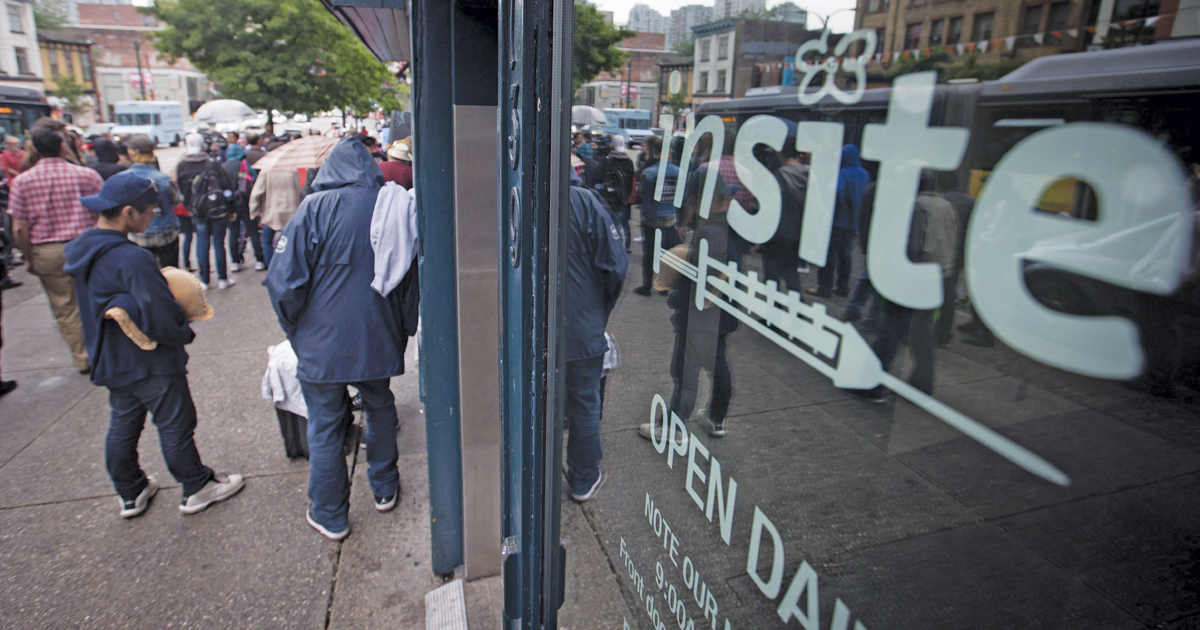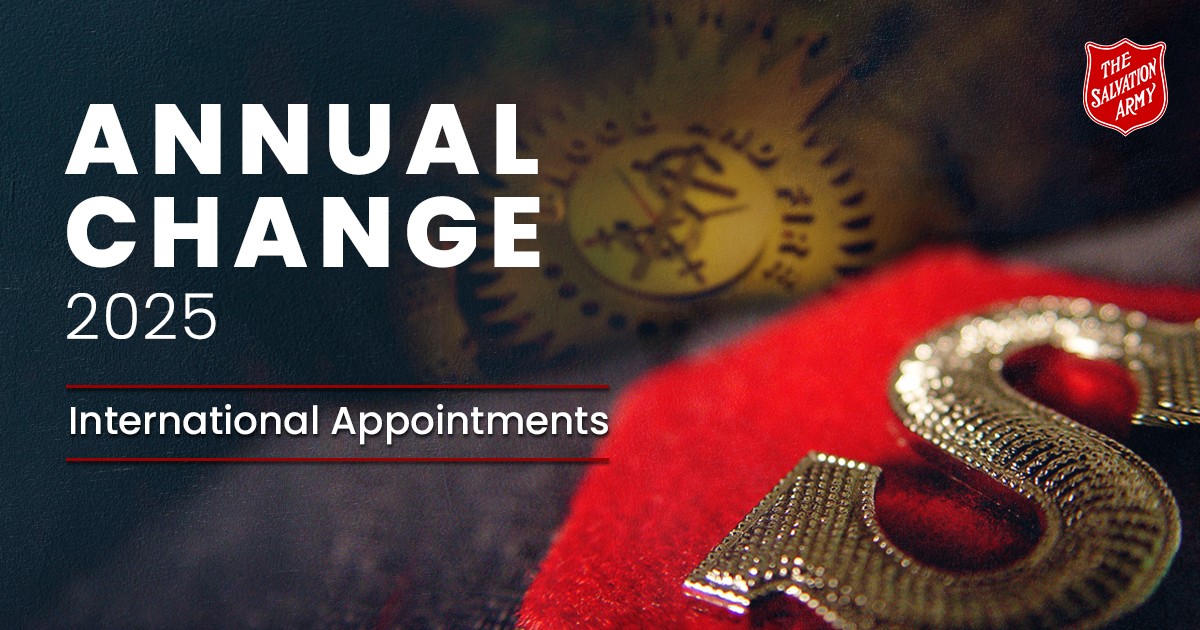(Above) People gather outside Insite, Canada's first supervised injection site, in Vancouver's Downtown Eastside, as part of a demonstration in 2016
Like many who do not battle addiction, I am confused about harm reduction as it relates to addiction and substance use. I also have a complicated history with it.
My first exposure to harm reduction was in 2008, when I was a senior advisor to federal Health Minister Tony Clement. A group of advocates and activists at an international HIV-AIDS conference in Mexico City approached the minister and asked about Insite, Canada’s first—and then only—sanctioned supervised injection site, in Vancouver. Clement was a passionate advocate for treatment and recovery, and a thoughtful, studious and hard-working critic of supervised injection. When questioned, he passionately defended his government’s position on supervised injection, referring to it as “palliative care—watching someone die slowly.” With the fervor of William Booth in his infamous “I’ll Fight!” speech, Clement declared, “I’m not going to give up on a single individual. I’m not going to give up on a single person who needs our help. That’s my role as a health minister. That’s why I believe so strongly that we have to do better than simply palliative care.” He went on to say “I believe that no person is too far gone. No addict is too far gone to give up on them.”
Clement was commenting on a Canadian Charter of Rights and Freedoms challenge regarding Insite’s exemption from provisions of the Controlled Drugs and Substances Act—an exemption that rested with the federal minister of health to grant or refuse. The exemption shielded Insite clients and staff from being charged with offences prohibiting possession or trafficking of illicit substances. Insite grew out of concerns about an epidemic of HIV and tuberculosis, growing rates of hepatitis C and overdose deaths, and the resulting public health emergency that was declared in Vancouver’s Downtown Eastside (DTES). As Justice Pitfield of the Supreme Court of British Columbia noted, the public health goals in the DTES were “to keep drug users alive, contain the communicable disease epidemics, and stop others from using.”
In 2008, I agreed with the government’s position. I agreed, and still do, that no one should be given up on. No one should be seen as too far gone. Giving up is inconsistent with Salvation Army values and the concept of the imago dei (the image of God). Supporting continued substance use—especially injection drug use—and “watching someone die slowly” seemed so terribly wrong and counterintuitive and at odds with the imago dei. I believed this deeply, as I watched my own mother die slowly less than a decade earlier as she battled addiction and mental illness.
But our courts disagreed. Between 2008 and 2011, successively higher courts ruled that removing Insite’s exemption would infringe the Charter-protected right to life, liberty and security of the person of Insite’s clients. The trial judge concluded, based on the expert evidence presented, that “one aspect of the illness [of addiction] is the continuing need or craving to consume the substance to which the addiction relates” despite the serious health consequences of consuming, and that Insite provided “access to a health-care facility where the risk of morbidity associated with infectious disease is diminished, if not eliminated.” That ruling paved the way for a change in public policy, and the expansion of supervised injection sites and supervised consumption sites across Canada.
After leaving my federal government role, I didn’t give much thought to harm reduction until I returned to work at The Salvation Army. I started to read news articles about the opioid crisis in British Columbia in 2017, and the national and significantly amplified opioid crisis during the pandemic in 2020. A temporary emergency hotel shelter with a supervised consumption site opened right next to my home in 2021. And then I personally witnessed the benefits of harm reduction.
Staying Alive
In January 2021, a friend was picked up by police and charged with impaired driving. My friend was experiencing anxiety and depression, expressing suicidal thoughts and had been self-medicating with alcohol and marijuana for months. He had also been prescribed medication to help with severe, often multi-day, insomnia brought on by the stresses of pandemic job interruptions, physical health problems that temporarily cost him his driver’s licence, relationship breakdown, and struggling to make ends meet on an income that was low to begin with and even lower on the Canada Emergency Response Benefit.
I, and several others who had never experienced addiction, made phone calls, explored detox and treatment options and gave my friend contact information. Although intoxicated most of the time, he knew he was in bad shape, and he was attempting to get to a friend’s house on the day he was detained by police. Because I am a lawyer, I was the first person he called from the police station. I picked him up and drove him to his friend’s house. The friend, who was himself on a journey of recovery from a nearly two-decade stint of legal and illicit drug use and addiction, would let my friend continue to use while he, hopefully, tapered off and dried out. As I dropped my friend off, others criticized my decision. Looking back through my text messages from that time, people wrote: “He needs to stop drinking.” “He needs detox.” “He needs to go to a hospital.” “If he stays there, things will get worse. You have to get him out of there now!”
From the outside looking in, I objectively and rationally agreed that my friend needed to go to detox, to stop drinking and to be in a place where he would not be tempted or permitted to keep consuming. But in the days, weeks and months that followed, I also came to realize that doing the “rational thing” would not change his mind or his body, both of which needed— mentally, emotionally and physically needed—to continue using at that time. In those moments, addiction was not a choice, consumption was not a choice, and my friend’s top priority was drinking enough to remain alive.
That night, I watched as his friend provided a safe and non-judgmental space. The two guys laughed over stories of their teenage years, when they did stupid things that could have cost them life and limb. They shared withdrawal stories and spoke of the difference between being “dope sick” and in alcohol withdrawal—something I have never experienced. I watched my friend (by that time experiencing withdrawal) vacillate between tears and indignation—feeling deep, deep shame and sorrow for the state he was in and the things he had done, while insisting other people were to blame for his condition. He wasn’t wrong on either front. I listened to his friend describe a key turning point in his own life—having to administer naloxone “to a kid”—and his subsequent journey of recovery, a journey that is not yet over, but that includes learning and sharing from his own experiences so that he can support and lift up those who are going through similar experiences.
Never Give Up
As I sat there that night, I saw harm reduction in action. I was reminded that society cannot condone addiction, but it also can’t fail to manage it; that abstinence is not always a realistic goal—at least not now and, for some people, maybe not ever. I saw the image, and the face and hand of God, in my friend and in my friend’s friend as he provided a safe, supportive and compassionate space. I saw community.
Although I still flinch when I see my new neighbours shooting up or smoking a crack pipe outdoors or when ambulances are dispatched in response to an overdose call, I have also resolved to learn more about addiction, to listen to the stories of those experiencing and recovering from addiction, and to advocate for greater compassion and support for people who, like my friend or my friend’s friend, might currently be so deep in the throes of addiction or mental illness, or both, that it is tempting to give up. But I will not give up. Will you join me in not giving up?
Dani Shaw is the director of public affairs for the Canada and Bermuda Territory.
The Salvation Army and Harm Reduction
Throughout its history, The Salvation Army has worked with people experiencing addiction to alcohol or drugs and has played an integral role in the recovery of countless people.
According to the Canadian Mental Health Association, Ontario, harm reduction is “an evidence-based, client-centred approach that seeks to reduce the health and social harms associated with addiction and substance use, without necessarily requiring people who use substances from abstaining or stopping.”
The Salvation Army recognizes that harm reduction is a spectrum, and that, as a public health intervention, it prevents the loss of human lives. The Salvation Army prefers to operate programs and services at the abstinence end of the harm reduction spectrum but acknowledges that abstinence may not always be feasible given the complex realities surrounding substance use. Structural factors have contributed to a social and health crisis in Canada, particularly in the use of opioids to treat physical and psychic pain. The Salvation Army recognizes that stigma surrounding substance use may have caused people to feel worthless. But we are committed to showing love, offering hope and protecting the dignity of others as a matter of organizational mission and commitment to following Jesus.
Social service funders in Canada are increasingly shifting toward a trauma-informed approach to service, which requires certain harm reduction practices (low-barrier admission criteria, access to harm reduction supplies, etc.) to meet client needs. The specifics of harm reduction programming can vary across jurisdictions, depending on geographical location (high-drug-use areas) and advocacy efforts, as well as public opinion and individual biases, experiences and capacities.
The social mission department is presently engaged in a research project to better understand how ministry units in the Canada and Bermuda Territory are navigating these complexities to meet people's needs for safety, recovery and wellness.
“Society cannot condone addiction, but in the face of its presence it cannot fail to manage it.”—Supreme Court of British Columbia in “PHS Community Services Society vs. Attorney General of Canada”
“Harm reduction refers to policies, programs and practices that aim to reduce risks and harm associated with the use of … substances. It acknowledges that abstinence is not always a realistic goal … recognize[s] the inherent value of human beings and the importance of an inclusive community that can support people who use substances with compassion.”—Alberta Health Services, Harm Reduction Services
Photo: THE CANADIAN PRESS/Darryl Dyck
This story is from:










Reposting my previous comment without all the typos(that'll teach me to post comments using my cell phone!)plus a couple more points:
Absolutely incredible how far down the wrong path the Salvation Army has gone. One can only assume it's because of reliance on government funding to stay alive.
They've gone from sharing the true gospel of transformation, to going along with progressive social policies. Baked into these policies is that human beings have no free will and no ability to choose to stop taking drugs. This nullifies the transformative power of the gospel.
It is NOT unassailable truth that addiction is an illness over which one has no power. Many learned people understand addiction as learned behaviour. While it can be very difficult to change, it remains a possibility. Our final freedom, as Victor Frankl asserted, is to make choices in our circumstances. The Salvation Army began as a ministry to the "least of these", many of whom were struggling with alcohol dependence. The gospel made the difference - no safe injection site or government supplied drugs needed.
William Booth should be turning over in his grave.